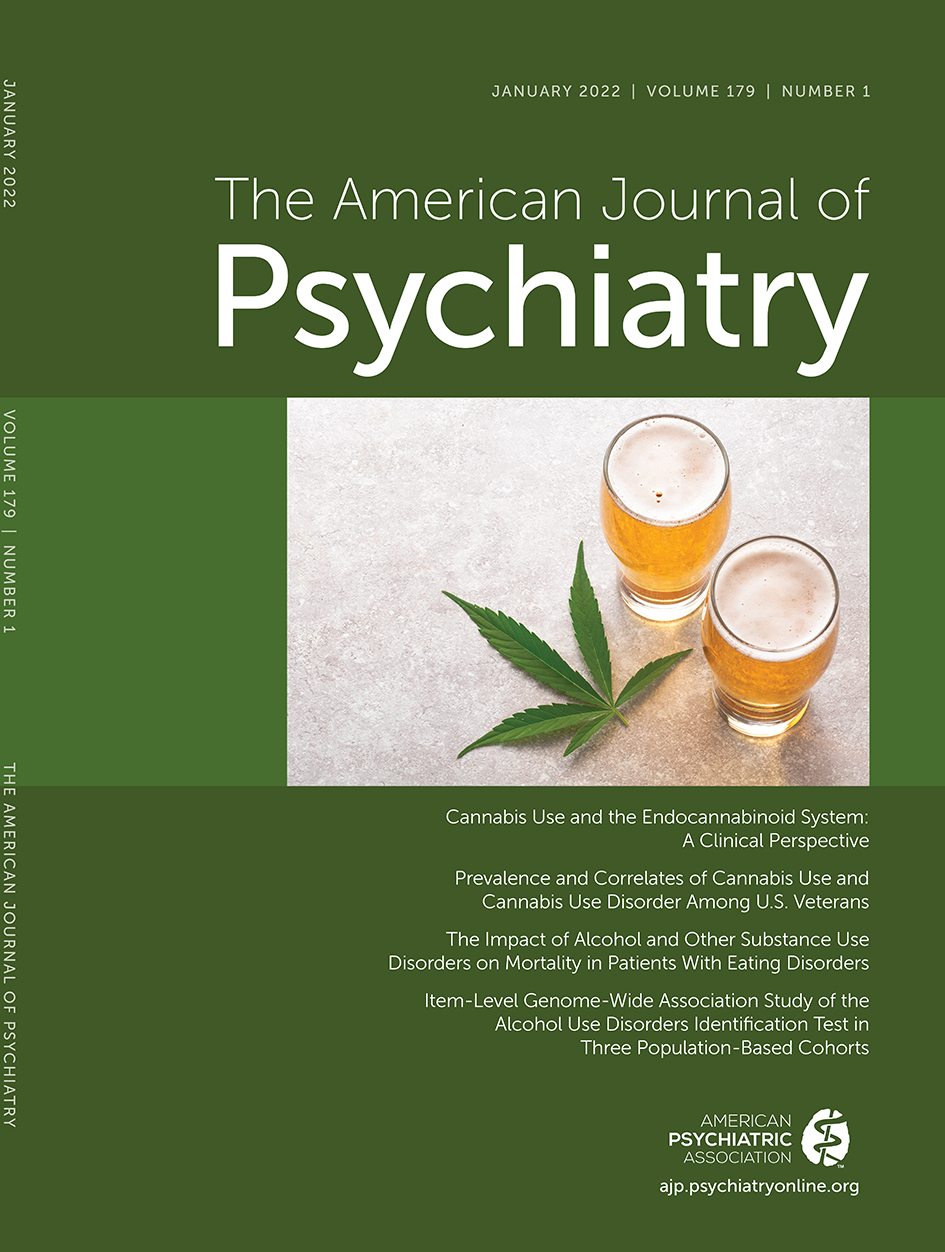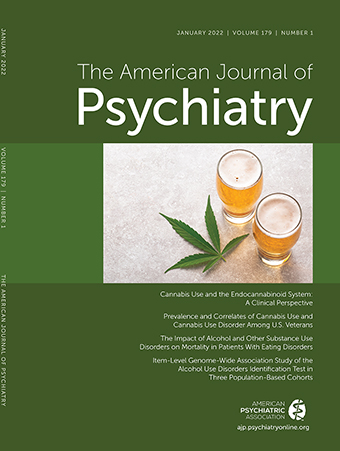In their article in this issue, Browne et al. (
1) present a dynamic approach to examining cannabis use and cannabis use disorder, based on DSM-5 criteria (
2), among veteran populations, using data from the 2012–2013 National Epidemiologic Survey on Alcohol and Related Conditions–III (NESARC-III). The authors highlight the paucity of research assessing cannabis use and use disorder among veterans in the United States and the acute need for ongoing surveillance of cannabis use in this population, and their work calls attention to the importance of examining the intricacies of cannabis research among U.S. veterans.
The veterans in this study were those who were no longer on active duty, but had served on active duty in the U.S. Armed Forces, National Guard, or Military Reserves. Sociodemographic characteristics were recorded in the NESARC-III sample; weighting was used to provide nationally representative results. After weighting, the sample comprised low proportions of women, younger people (particularly the 18- to 29-year age range), individuals not identifying as White, rural residents, people with less than a high school education, individuals experiencing unemployment, and people in the lowest family income bracket ($0–$19,999). The Alcohol Use Disorder and Associated Disabilities Interview Schedule–5 (AUDADIS-5) was used to measure lifetime and past-12-month cannabis use. Use was categorized as nonmedical use alone (use without a prescription or to get high one or more times in the past 12 months), medical use alone, or both. Respondents who disclosed medical cannabis use alone were not asked questions related to cannabis use disorder, so no cannabis use disorder–related information on this small group could be provided. Extensive information is provided on the reliability and validity of DSM-5 diagnoses using the AUDADIS-5 (
3), and the kappa values were within the norm for structured clinical interviews of this type. Previous use of DSM-IV to compare findings from the AUDADIS-ADR, the Composite International Diagnostic Interview, and the Schedules for Clinical Assessment in Neuropsychiatry determined that agreement between cannabis use disorder findings were less than for any other substance use disorder (
4). However, this comparison was based on DSM-IV (
4), not DSM-5 as used by Browne et al.
The Browne et al. study likely underestimated cannabis use and use disorder among U.S. veterans. The prevalence of past-12-month cannabis use was 7.3%, and the prevalence of past-12-month cannabis use disorder was 1.8%, as assessed by DSM-5 criteria. The authors point out that previous research in patients of the Veterans Health Administration revealed greater prevalence of use but lower prevalence of cannabis use disorder (
5–
7). However, in an earlier study, Hasin et al. found a higher prevalence of past-12-month cannabis use disorder among adults sampled in the 2012–2013 NESARC-III (
8) than did Browne et al. in their veterans-only subsample. This highlights the importance of comparing prevalence estimates from subpopulations to those of a nationally representative sample, given that some may assume higher drug use among people after military service.
Additionally, Browne et al. observed a positive association between lifetime cannabis use disorder and answers that met the criteria for lifetime posttraumatic stress disorder (PTSD). Studies have considered rates of comorbidity of PTSD and cannabis use disorder among veterans (
9,
10), and have also considered the use of cannabis to treat PTSD. For instance, a majority (58.5%) of veterans in one health group sample self-reported cannabis use to treat PTSD (
11). A study by Petersen et al. (
12) found no positive effect of cannabis on PTSD; only antidepressants reduced PTSD symptoms in that study, in a largely white and male sample. A randomized clinical trial also did not reveal significant differences in improving PTSD symptoms when comparing several types of smoked cannabis to placebo (
13). A small qualitative study among veterans with PTSD found some positive but also some negative consequences associated with medical cannabis use (
14). Additional research regarding the effectiveness and efficiency of using cannabis to treat PTSD symptoms in veterans may be warranted.
We simply don’t know if those using cannabis only medically also experienced the consequences measured as cannabis use disorder, because of an enduring quandary in the nosology of cannabis use disorder. The AUDADIS and some other measures characterize use disorder only when the person endorses nonmedical use. But differentiating medical from nonmedical cannabis use, even conceptually, remains fraught with challenges. Some people who have a medical prescription for cannabis may also use cannabis for its mood-altering properties; thus, they may endorse using to get high and also using for pain relief. Some individuals may want to receive medical cannabis but be unable or unwilling to obtain a prescription because of a lack of health insurance or financial resources, limited geographical access to a prescribing health professional for medical marijuana, or concerns about the potential stigmatization of asking for, receiving, or using medical cannabis. Others may have a health provider endorse their medical use but may similarly experience barriers to purchasing through an authorized dispensary. As previously noted, in the Browne et al. study, nonmedical cannabis use was classified as endorsing using cannabis without a prescription or a medical referral or using it in a manner other than as prescribed. Since the types of qualifying health conditions for medical marijuana vary by state, an individual may qualify for medical use in one state but not in another, so cannabis could be used for a health-related concern that currently does not qualify for medical use in a particular state. Thus, accurate measurement of whether cannabis was used medically and/or nonmedically is a particularly complex issue, and when AUDADIS-5 questions that measure problematic use and negative consequences of use are not asked of individuals who endorsed medical use alone, this likely leads to underestimation of the prevalence of cannabis use disorder.
Another particularly notable finding from the Browne et al. study was that veterans who endorsed past 12-month cannabis use also had increased odds of a past-12-month opioid use disorder and increased odds of using cannabis. The authors point to another study that suggests a positive association between using cannabis in 2001–2002 and incidence of an opioid use disorder in 2004–2005 among U.S. adults with moderate to severe pain (
1,
15). However, other research has found that cannabis use may help manage symptoms related to opioid use, such as withdrawal (
16–
18). Findings from Browne et al. also revealed that prevalence of past-12-month nonmedical cannabis use and, more concerningly, prevalence of cannabis use disorder are higher in U.S. states with medical marijuana laws compared with those that have not legalized medical marijuana. Given that U.S. states are increasingly legalizing not only medical but also recreational marijuana use, the findings of Browne et al. contribute to a growing literature supporting the need for further research on the implications of changing legalization and public policy regarding cannabis use for veterans. While Veterans Administration health professionals are currently prohibited from prescribing medical marijuana (
19), it is critical that veterans using cannabis receive medical guidance regarding the risks and benefits of cannabis use, regular screenings for cannabis use disorder, and timely and appropriate access to resources and support services related to cannabis use, especially if they experience adverse symptoms associated with use.

